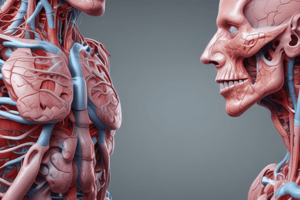Podcast
Questions and Answers
What does the suffix -itis signify in medical terminology?
What does the suffix -itis signify in medical terminology?
- Tumor
- Inflammation (correct)
- Surgical procedure
- Disease
Which of the following best describes the difference between the terms anterior and posterior?
Which of the following best describes the difference between the terms anterior and posterior?
- Anterior is synonymous with medial and posterior with lateral.
- Anterior refers to the upper body, while posterior refers to the lower body.
- Anterior refers to the front of the body, while posterior refers to the back. (correct)
- Anterior refers to the back of the body, while posterior refers to the front.
What do the prefixes hyper- and hypo- indicate?
What do the prefixes hyper- and hypo- indicate?
- Above normal and below normal conditions. (correct)
- Normal and abnormal levels of something.
- Permanent and temporary conditions, respectively.
- Rapid increase and gradual decrease.
Which term correctly describes the relationship between origin and insertion in muscle anatomy?
Which term correctly describes the relationship between origin and insertion in muscle anatomy?
What does the suffix -pathy signify in medical terminology?
What does the suffix -pathy signify in medical terminology?
Flashcards are hidden until you start studying
Study Notes
Prefixes
- Hyper - means above or excessive.
- Hypo - means below or deficient.
- Epi - means above or upon.
- Circum - means around or encircling.
- -itis - means inflammation.
Anatomical Position
- Refers to the body standing erect, arms at the sides, palms facing forward, feet slightly apart.
Body Cavities
- Cranial Cavity - located within the skull and contains the brain.
- Vertebral Cavity - located within the vertebral column and contains the spinal cord.
- Thoracic Cavity - located within the chest and contains the heart, lungs, and major blood vessels.
- Abdominal Cavity - located within the abdomen and contains the stomach, intestines, liver, gallbladder, pancreas, spleen, and kidneys.
- Pelvic Cavity - located within the pelvis and contains the bladder, reproductive organs, and rectum.
Directional Terms
- Anterior - refers to the front of the body.
- Posterior - refers to the back of the body.
- Superior - towards the head or upper part of the body.
- Inferior - towards the feet or lower part of the body.**
- Medial - nearer to the midline of the body.
- Lateral - further from the midline of the body.
Movement Terms
- Flexion - refers to bending of a joint to decrease the angle between bones.
- Extension - refers to straightening of a joint to increase the angle between bones.
- Pronation - refers to turning the palm of the hand downwards or inward.
- Supination - refers to turning the palm of the hand upwards or outward.
Additional Terms
- Pruritus - refers to severe itching, often associated with skin conditions like hives.
- Vertebrae - are the bones that make up the spinal column.
- Cervical Vertebrae (neck) - 7
- Thoracic Vertebrae (chest) - 12
- Lumbar Vertebrae (lower back) - 5
- Sacral Vertebrae (pelvis) - 5
- Coccygeal Vertebrae (tailbone) - 4
- Origin - refers to the attachment of a muscle to the more stationary bone.
- Insertion - refers to the attachment of a muscle to the more movable bone.
- -ology - refers to a field of study or branch of knowledge.
- -gist - refers to a specialist in a particular field of study.
- -pathy - refers to a disease or condition.
Studying That Suits You
Use AI to generate personalized quizzes and flashcards to suit your learning preferences.





